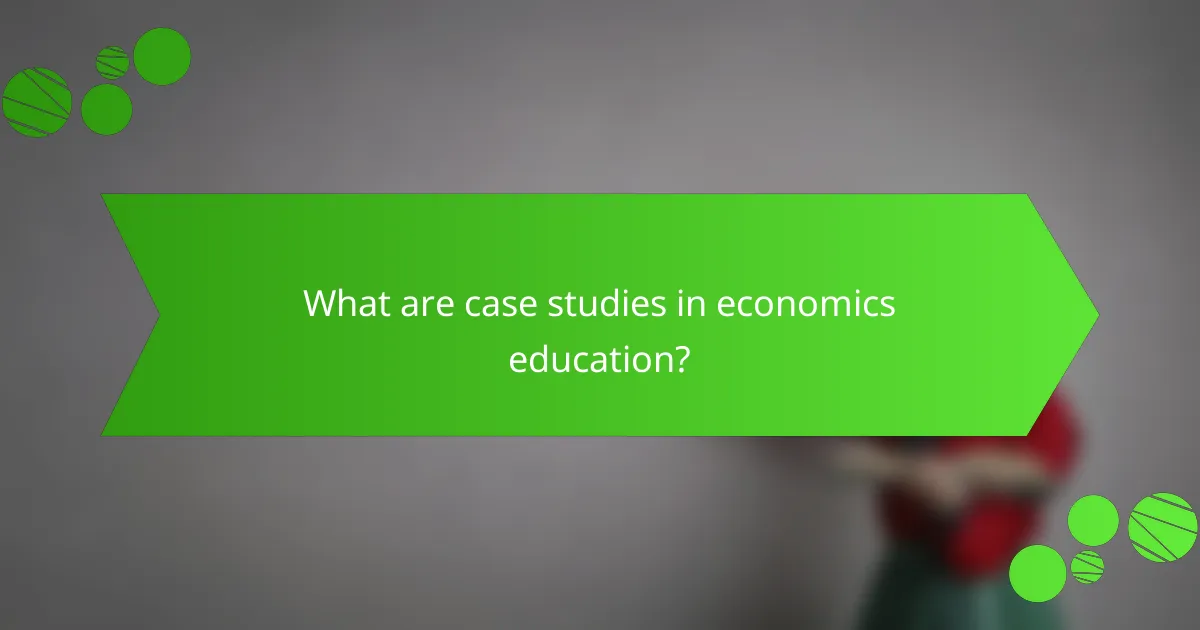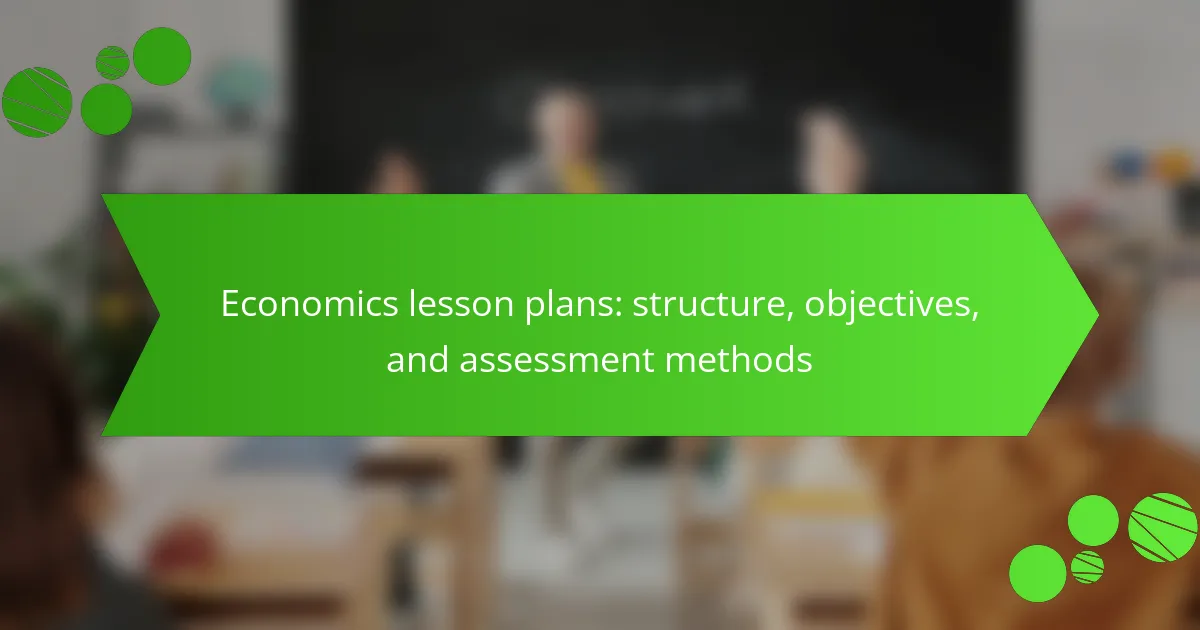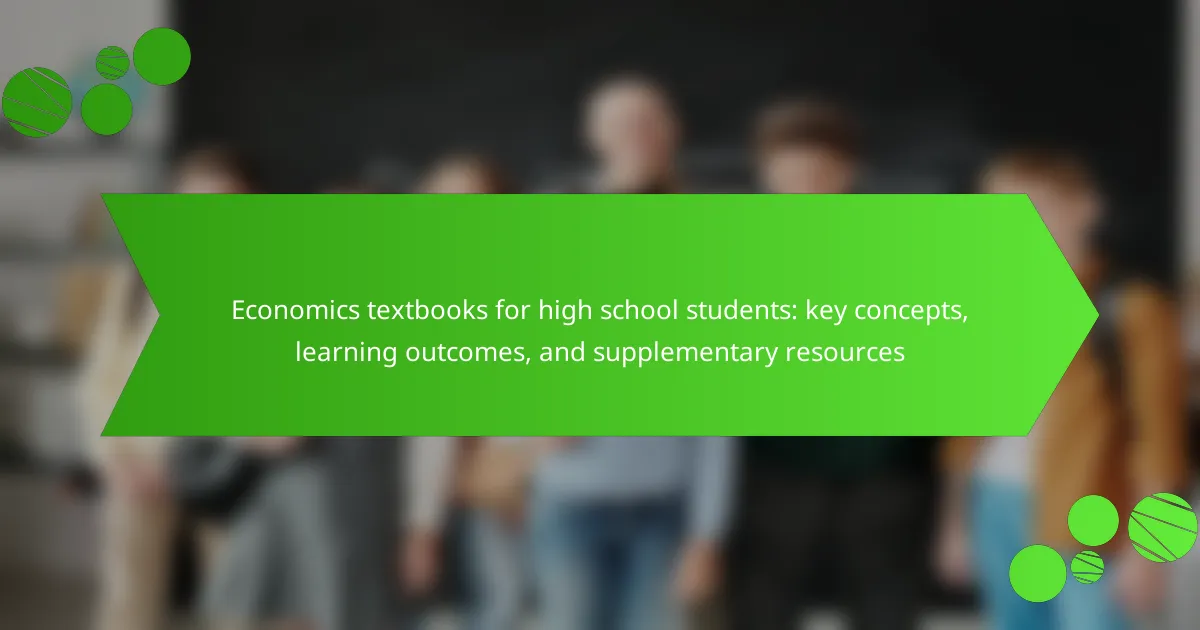Case studies in economics education are detailed examinations of real-world economic situations that enhance students’ understanding of economic theories and concepts. These case studies promote critical thinking, problem-solving, and collaborative learning, allowing students to apply theoretical knowledge in practical contexts. Various analysis techniques, including qualitative and quantitative methods, cost-benefit analysis, and scenario analysis, are utilized to evaluate these scenarios effectively. Effective teaching strategies, such as active learning and group discussions, further engage students and improve their comprehension of economic principles. Overall, the integration of case studies in economics education serves to bridge the gap between theory and practice, fostering deeper learning outcomes.

What are case studies in economics education?
Case studies in economics education are in-depth analyses of real-world economic scenarios. They provide students with practical examples of economic theories and concepts. Case studies encourage critical thinking and problem-solving skills. They often involve data analysis and interpretation. This method allows students to apply theoretical knowledge to real-life situations. Research shows that case studies enhance student engagement and retention of information. They also foster collaborative learning among peers. Overall, case studies serve as a bridge between theory and practice in economics education.
How do case studies enhance economics learning?
Case studies enhance economics learning by providing real-world contexts for theoretical concepts. They allow students to analyze complex economic scenarios. This analysis improves critical thinking and problem-solving skills. Case studies also facilitate active learning through group discussions and presentations. They encourage the application of economic theories to practical situations. Research shows that students retain information better when engaged in case study analysis. A study by the Harvard Business School found that case-based learning increases student engagement and understanding. Overall, case studies bridge the gap between theory and practice in economics education.
What types of case studies are commonly used in economics education?
Common types of case studies used in economics education include industry analysis, policy evaluation, and market behavior studies. Industry analysis case studies focus on specific sectors, examining their performance and challenges. Policy evaluation case studies assess the impacts of government policies on economic outcomes. Market behavior studies explore consumer choices and business strategies in various contexts. These case studies help students apply theoretical concepts to real-world scenarios. They encourage critical thinking and analytical skills. By studying these cases, students gain insights into the complexities of economic systems.
How do case studies compare to traditional teaching methods?
Case studies engage students in practical, real-world scenarios, unlike traditional teaching methods that often focus on theoretical knowledge. Case studies promote critical thinking and problem-solving skills by requiring students to analyze complex situations. Traditional methods typically involve lectures and rote memorization, which may not foster deep understanding. Research shows that students retain information better when they apply concepts in real-life contexts. A study by the Harvard Business School found that case-based learning increases student engagement and improves learning outcomes. Additionally, case studies encourage collaboration through group discussions, enhancing communication skills. In contrast, traditional methods often isolate students in individual learning experiences.
Why are real-world applications important in economics education?
Real-world applications are important in economics education because they enhance understanding and retention of economic concepts. Students can better grasp theoretical principles when they see their relevance in everyday life. For example, case studies that illustrate market behavior or consumer choices make abstract ideas tangible. Research shows that students engaged in practical applications perform better on assessments. A study by the National Bureau of Economic Research found that experiential learning increases student performance by up to 20%. This connection between theory and practice fosters critical thinking skills. It also prepares students for real-world decision-making in their future careers.
What are some examples of real-world applications in economics case studies?
Real-world applications in economics case studies include the analysis of the 2008 financial crisis. This case study examines the causes and impacts of the crisis on global economies. Another example is the study of minimum wage increases in various states. These studies assess the effects on employment and business operations. The case of the 1997 Asian financial crisis provides insights into currency devaluation and economic recovery strategies. Additionally, the impact of trade policies on local industries is explored in case studies of NAFTA. These applications illustrate how theoretical concepts manifest in practical scenarios, providing valuable lessons for students.
How do real-world applications affect student engagement and understanding?
Real-world applications significantly enhance student engagement and understanding. They connect theoretical concepts to practical scenarios. This connection fosters interest and motivation among students. Engaging with real-world examples makes learning more relevant. Research indicates that students retain information better when it is applied to real-life situations. A study by the National Center for Education Statistics shows that hands-on learning increases comprehension. Additionally, real-world applications promote critical thinking and problem-solving skills. They encourage students to analyze and evaluate information actively. Overall, integrating real-world applications in education leads to deeper learning experiences.

What analysis techniques are utilized in economics case studies?
Economics case studies utilize various analysis techniques to evaluate real-world scenarios. Common techniques include qualitative analysis, which examines non-numerical data for insights. Quantitative analysis involves statistical methods to analyze numerical data. Cost-benefit analysis assesses the economic viability of projects by comparing costs and benefits. Comparative analysis contrasts different cases to highlight variations and outcomes. Regression analysis identifies relationships between variables, helping to predict trends. Additionally, scenario analysis explores potential future developments based on different assumptions. These techniques are essential for drawing meaningful conclusions in economics education.
How do qualitative and quantitative analysis techniques differ in case studies?
Qualitative and quantitative analysis techniques differ significantly in case studies. Qualitative analysis focuses on understanding phenomena through non-numeric data. It often involves interviews, observations, and content analysis. This method seeks to explore underlying reasons and motivations. In contrast, quantitative analysis relies on numeric data and statistical methods. It uses surveys, experiments, and existing datasets to quantify relationships and outcomes. Quantitative techniques enable hypothesis testing and the ability to generalize findings. For example, a qualitative study might explore student experiences in economics education through interviews. A quantitative study might analyze test scores to identify trends in student performance. Each technique offers unique insights, making them complementary in case study research.
What tools are commonly used for qualitative analysis in economics education?
Common tools for qualitative analysis in economics education include interviews, focus groups, and content analysis. Interviews allow educators to gather in-depth insights from students and experts. Focus groups facilitate discussions that reveal collective perspectives on economic concepts. Content analysis examines educational materials and student submissions to identify themes and patterns. These tools support a deeper understanding of student experiences and learning outcomes. Research indicates that qualitative analysis enhances the effectiveness of teaching strategies in economics education.
What statistical methods are employed in quantitative analysis of case studies?
Quantitative analysis of case studies employs various statistical methods. Common methods include descriptive statistics, inferential statistics, and regression analysis. Descriptive statistics summarize data through measures like mean, median, and standard deviation. Inferential statistics allow for conclusions about populations based on sample data. Regression analysis identifies relationships between variables and predicts outcomes. Other methods include t-tests and ANOVA for comparing groups. These methods provide a structured approach to analyze data effectively. They enhance the understanding of economic phenomena in educational contexts.
Why is data interpretation crucial in case study analysis?
Data interpretation is crucial in case study analysis because it enables researchers to derive meaningful insights from raw data. Accurate interpretation transforms data into actionable knowledge. It allows for identifying patterns, trends, and correlations that inform decision-making. In economics education, this is essential for understanding complex real-world scenarios. Data interpretation also aids in validating hypotheses and theories presented in case studies. It enhances critical thinking skills among students, preparing them for practical applications in their future careers. Moreover, effective data interpretation supports evidence-based conclusions, which are vital for academic rigor and credibility.
How can students effectively interpret economic data from case studies?
Students can effectively interpret economic data from case studies by following structured analytical techniques. First, they should identify key economic indicators relevant to the case. This includes variables like GDP, inflation rates, and unemployment figures. Next, students should analyze trends over time within the data. They can use graphs and charts to visualize these trends clearly.
Additionally, students should compare the case study data with industry benchmarks. This helps to contextualize the findings and assess performance. Engaging with primary sources, such as government reports and academic articles, can provide additional insights. Critical thinking is essential; students must question assumptions and consider alternative explanations.
Finally, discussing findings with peers enhances understanding through collaborative analysis. Research shows that collaborative learning improves data interpretation skills (Johnson & Johnson, 2014).
What common pitfalls should students avoid when interpreting data?
Students should avoid confirmation bias when interpreting data. This occurs when they favor information that supports their pre-existing beliefs. Ignoring contradictory evidence can lead to flawed conclusions. They must also be cautious of overgeneralization. Drawing broad conclusions from limited data can misrepresent the findings. Misinterpreting correlation as causation is another common pitfall. Correlation does not imply one variable causes the other. Additionally, students should be wary of data dredging. This involves searching for patterns without a hypothesis, which can produce misleading results. Lastly, neglecting the context of the data can lead to misinterpretation. Understanding the circumstances surrounding the data is crucial for accurate analysis.

What teaching strategies are effective for implementing case studies in economics education?
Effective teaching strategies for implementing case studies in economics education include active learning, group discussions, and real-world applications. Active learning engages students in the learning process. This can be achieved through problem-solving tasks related to the case study. Group discussions foster collaboration and allow students to share diverse perspectives. Real-world applications help students connect theoretical concepts to practical scenarios. According to a study by Garrison and Anderson (2003), these strategies enhance student engagement and comprehension. Implementing these approaches can lead to improved critical thinking skills among students.
How can educators design effective case study assignments?
Educators can design effective case study assignments by clearly defining learning objectives. These objectives should align with course goals and student needs. Next, educators should select relevant and engaging case studies. Real-world scenarios enhance student interest and application of concepts.
Incorporating diverse perspectives within case studies fosters critical thinking. This can include economic, social, and ethical dimensions. Educators should provide structured guidelines for analysis. Clear instructions help students understand expectations and assessment criteria.
Feedback mechanisms are also essential. Timely and constructive feedback promotes student learning and improvement. Finally, integrating group discussions enhances collaborative learning. This approach encourages students to share insights and develop a deeper understanding of the material.
What criteria should be considered when selecting case studies for students?
Criteria for selecting case studies for students include relevance, complexity, and learning objectives. Relevance ensures the case study aligns with the curriculum and students’ interests. Complexity should match students’ skill levels to facilitate understanding. Learning objectives must be clear, guiding the teaching focus. The case study should also provide real-world applications to enhance engagement. Availability of data and resources is essential for thorough analysis. Lastly, diversity in case studies promotes varied perspectives and critical thinking.
How can group discussions enhance the learning experience with case studies?
Group discussions enhance the learning experience with case studies by fostering collaborative learning. They encourage students to share diverse perspectives. This exchange of ideas deepens understanding of complex concepts. Engaging in discussions also promotes critical thinking skills. Students analyze case study details more thoroughly when collaborating. According to a study by Johnson and Johnson, cooperative learning increases retention rates by 50%. Group discussions create a supportive environment for asking questions. This leads to a more comprehensive exploration of case study implications. Overall, discussions transform individual learning into a collective educational experience.
What role does feedback play in case study learning?
Feedback is essential in case study learning as it enhances understanding and application of concepts. It provides students with insights into their performance and areas for improvement. Constructive feedback helps learners identify strengths and weaknesses in their analysis. This process encourages critical thinking and deeper engagement with the material. Research indicates that timely feedback significantly improves learning outcomes. For instance, studies show that students who receive feedback perform better in subsequent assessments. Feedback also fosters a collaborative learning environment, allowing for peer-to-peer interaction. Overall, feedback is a vital component that drives the effectiveness of case study learning.
How can educators provide constructive feedback on case study analyses?
Educators can provide constructive feedback on case study analyses by focusing on specific strengths and weaknesses. They should identify key areas where students excelled, such as analytical skills or application of theory. Additionally, educators must highlight areas needing improvement, like depth of analysis or clarity of arguments.
Feedback should be specific and actionable. For instance, suggesting additional sources or frameworks can enhance understanding. Educators should encourage critical thinking by asking probing questions. This helps students reflect on their reasoning and conclusions.
Furthermore, timely feedback is crucial for student growth. Providing it shortly after submission allows students to integrate suggestions into future work. Regularly using a rubric can standardize feedback and make it easier for students to understand expectations.
Research shows that specific feedback leads to better learning outcomes. A study by Hattie and Timperley (2007) emphasizes the importance of feedback in the learning process. Thus, constructive feedback not only guides students but also fosters their analytical skills in economics education.
What are the benefits of peer feedback in case study assignments?
Peer feedback in case study assignments enhances learning outcomes and promotes critical thinking. It allows students to receive diverse perspectives on their work. This interaction fosters a deeper understanding of the subject matter. Peer feedback also encourages collaborative learning and communication skills. Studies indicate that students who engage in peer review show improved performance on assignments. Research shows that feedback from peers can be as effective as instructor feedback. Additionally, it helps students develop the ability to assess and critique their own work. Overall, peer feedback enriches the educational experience in case study assignments.
What best practices can educators adopt for successful case study teaching?
Educators can adopt several best practices for successful case study teaching. First, they should select relevant and engaging cases that resonate with students’ experiences. This enhances interest and motivation. Second, educators should encourage active participation through discussions and group work. This promotes critical thinking and collaboration among students. Third, they must provide clear guidelines and expectations for assignments related to the case studies. Clarity helps students understand objectives and assessment criteria. Additionally, integrating diverse perspectives in case analysis enriches learning. This approach fosters a deeper understanding of complex issues. Finally, continuous feedback is essential throughout the process. Feedback helps students refine their analytical skills and apply theoretical concepts effectively. These practices contribute to a more impactful case study teaching experience.
How can technology be integrated into case study teaching strategies?
Technology can be integrated into case study teaching strategies through various tools and platforms. Online collaboration tools enable students to work together on case studies in real time. Learning management systems can host case study materials and facilitate discussions. Simulation software allows students to engage in realistic scenarios and decision-making processes. Video conferencing tools support remote discussions and presentations. Data analysis software aids in interpreting case study data effectively. These integrations enhance engagement and understanding, making the learning experience more interactive and applicable to real-world situations.
What resources are available for educators to improve case study methods?
Educators can access various resources to enhance case study methods. Online platforms like Harvard Business Publishing provide extensive case studies for educational use. The Case Centre offers a wide range of case studies and teaching notes. Additionally, the Association for Educational Communications and Technology provides research and guidelines on effective case study teaching. Journals such as the Journal of Economic Education publish articles focused on case study methodologies in economics. Workshops and webinars hosted by professional organizations also offer practical insights and strategies. These resources collectively support educators in refining their case study approaches.
Case studies in economics education serve as in-depth analyses of real-world economic scenarios, providing students with practical applications of economic theories and concepts. This article explores how case studies enhance learning by fostering critical thinking, problem-solving skills, and collaborative learning among students. It discusses various types of case studies commonly used, such as industry analysis and policy evaluation, and compares their effectiveness to traditional teaching methods. Additionally, the article outlines analysis techniques, including qualitative and quantitative methods, and emphasizes the importance of real-world applications in improving student engagement and understanding. Finally, it highlights effective teaching strategies and resources for educators to implement case studies successfully in economics education.



